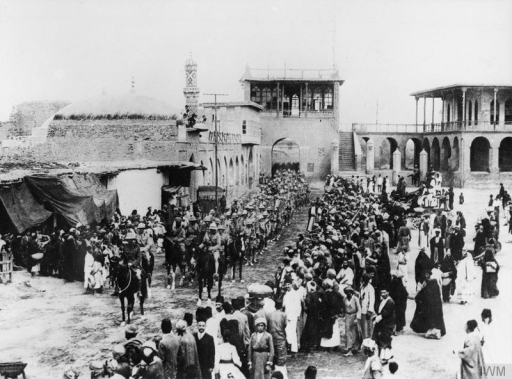100 years ago, Britain was digesting news of the humilating fall of Kut-al-Amara after a five-month siege. Paul Knight discusses Sir Frederick Maude, the General who would go on to capture Baghdad in 1917 after rebuilding British and Indian forces in Mesopotamia.
Opinion on the Mesopotamia Campaign is usually dominated by the ignominy of the siege of Kut and the surrender of Major General Sir Charles Townsend – Townsend of Kut – and his 6th (Poona) Division.
Kut was the longest siege endured by the British Army. It was also the greatest surrender of British troops since Yorktown (1781) and would only be exceeded by the fall of Singapore (1942). Yet outside the siege of Kut, the campaign was one of largely overlooked near continuous victories. In the aftermath of Kut, Frederick Stanley Maude would rebuild the battered army to resume those victories.
At the outbreak of the First World War, Maude was a colonel in the Training Directorate in the War Office. His only active service command had been as a company commander during the Boer War over a decade before. His wartime career was both meteoric and unexpected, and earned him a place in John Singer Sergeant’s 1922 painting ‘General Officers of World War I’.
In October 1914, Maude was promoted to command the battered 14th Brigade in fighting around Ypres. The following April he was severely wounded in the spine. While convalescing in England he was promoted first to GOC 33rd Division (then still being raised) and then in August 1915 to command 13th (Western) Division at Gallipoli. Maude’s learning curve was steep in the extreme, and all on active service.
Last out at Gallipoli
13th Division moved to Helles for the final evacuation of Gallipoli. Characteristically, Maude was the last man to leave; the penultimate person to leave was a subaltern in 6/South Lancashire Regiment and later the British Labour Prime Minister who defeated Winston Churchill in 1945, Clement Attlee.
The following month, February 1916, saw the division sailing for Mesopotamia and the relief of Kut. Their efforts would be to no avail, as Maude wrote in his diary for 25 April 1916:
“Indications are that we are going to leave Kut to its fate. Things have not been well managed. Our advance has been slow, although I grant that the conditions have been indescribably… General Townshend [sic] has complicated matters by not saying definitely the date on which his supplies would run out”.
In the aftermath of Townsend’s surrender, there was the expected cull of failed generals. In July, Maude succeeded Sir George Gorringe as GOC Tigris Corps. Gorringe spent the rest of the war as GOC 47th Division on the Western Front where his Chief of Staff was the future Field Marshal Bernard Montgomery. In August 1916 Maude succeeded Sir Percy Lake as Commander-in-Chief Mesopotamia.
The summer of 1916 saw the opportunity to re-build the battered Tigris Corps, which was restructured as the Mesopotamia Expeditionary Force of I and III Indian Corps. Due to the extreme heat, there was no campaigning, which fortunately gave the MEF some much needed space.
Logistics
The first task was to greatly increase the capacity of his logistics. Railways were laid (using track, engines and rolling stock from India), roads constructed, bunds built to hold back the Biblical floods. More steamers and barges also arrived. Maude was fortunate that orders for these had been put in place before he took command. Reinforcements arrived to bring his depleted divisions up to strength.
The air component was expanded and modernised. Aerial photography allowed for Mesopotamia to be accurately mapped for the first time and aircraft fitted with radios made air observation for the artillery possible. The Royal Navy’s fleet of ‘China Gunboats’ provided invaluable support, in transport, naval gunfire support and pursuing a broken enemy.
However, before all these improvements could take effect, the summer of 1916 was the hottest in living memory. The cooling Shamal wind which usually started in June was a month late. Lance Corporal Roe, 6th Bn, East Lancashire Regiment, recorded the conditions:
“16 May temperature is 115* in the shade.
29 – 31 May Heat unbearable, millions of flies and billions of mosquitoes make life a living hell both day and night”.
(*46 degrees Celsius)
In the heat, tinned corned beef liquefied and was unappetising with biscuits. R. Campbell Begg, a medical officer with 7th (Meerut) Division, titled his chapters of that summer: ‘Heat-Stroke’, ‘Scurvy’, ‘Cholera’, ‘Monotony’ and ‘Sweat’.
The improvements would mean that when Maude resumed the advance on Baghdad, he did so with far more infantry, and more logistical, naval and air support, than when Townsend made his advance in 1915 – a fact which Townsend noted while in captivity.
Further Reading:
P. Knight, The British Army in Mesopotamia 1914 – 1918
R. Campbell Begg, Surgery on Trestles
P. Downham, Diary of an Old Contemptable
A. Syk, ‘The Military Papers of Lieutenant-General Sir Frederick Stanley Maude, 1914 – 1917’ Army Records Society
C. Townsend, My Campaign in Mesopotamia
Images courtesy of Imperial War Museums © IWM (Q 24168)
© Centenary News & Author
